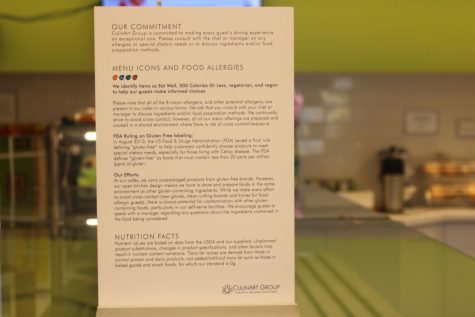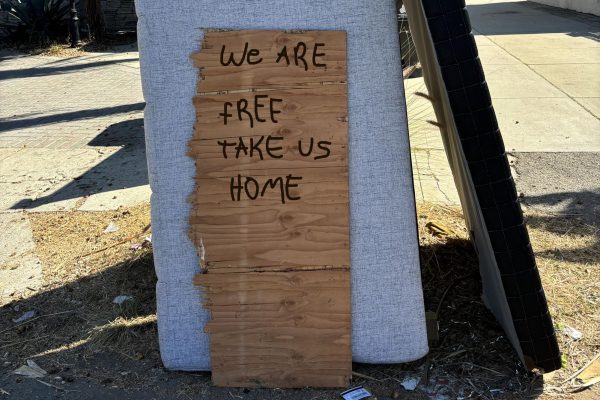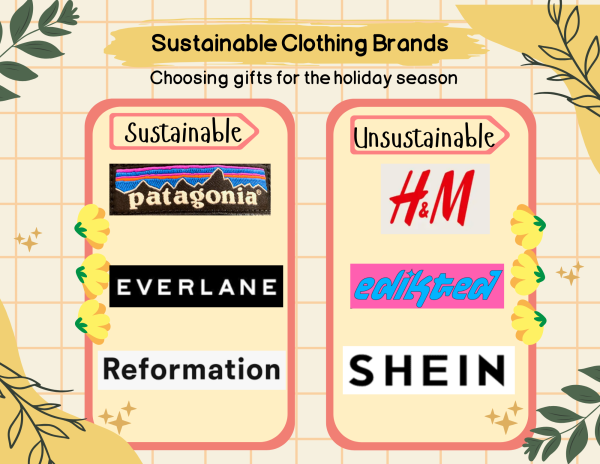‘Still a lot to learn’: Food allergy awareness, psychological impact
Photo credit: Stephan Moccio
Sophomore Elle Moccio stands in front of a poster at the Southern California Food Allergy Institute as she finishes her allergy treatment there. On Dec. 3, 2019, Moccio achieved food freedom when she finished her treatment that slowly desensitized her to her peanut allergy.
Eating at a restaurant. Having lunch at school with friends. Going to birthday parties. While these may seem like the simplest of everyday activities, for people with food allergies, they can be difficult and anxiety-inducing.
This is the reality for the 32 million people and 8% of children in the United States who have food allergies. A food allergy is an abnormal reproducible response of the body’s immune system to aspects of certain foods that cause potentially dangerous allergic reactions. These reactions can include hives, swelling, trouble breathing, fainting or anaphylaxis in a severe case, which can be life-threatening.
According to research from FARE, Food Allergy Research and Education, the foods that account for the most serious allergic reactions in the U.S. are milk, eggs, fish, crustacean shellfish, wheat, soy, peanuts and tree nuts. Food allergies have an economic, psychological and social impact on children and families. Caring for kids with food allergies costs American families about $25 billion yearly, and one in three kids with food allergies report bullying as a result.
Food allergies have rapidly increased in recent years for both children and adults. Childhood peanut and tree nut allergy has more than tripled between 1997 and 2008, and there’s been a 377% increase in the treatment of diagnosed anaphylactic reactions to food from 2007 to 2016.
Psychological Impact of Food Allergies
A study from Columbia University’s Mailman School of Public Health and Albert Einstein College of Medicine found that children with food allergies had a significantly higher prevalence of childhood anxiety, with 57% of children with food allergies reporting anxiety symptoms compared to 48% of children without a food allergy. Dr. Peck Ong, attending physician at CHLA, expert in Allergy and Immunology and Associate Professor of Pediatrics at the Keck School of Medicine of USC, works with patients, particularly children, with food allergies and eczema.
“[There’s] increased anxiety for parents [and] for the patients,” Ong said. “Having to avoid foods that are so prevalent and having this anxiety that the reaction might be life-threatening — that can be a problem for the quality of life.”
Elle Moccio (’24) had a severe allergy to peanuts throughout most of her life, but she participated in a treatment in 2019 that desensitized her to the allergen. She discovered her allergy as a 3-year-old, and because of this, her allergies made it difficult to participate in the same social activities as other kids.
“Being so young, I couldn’t really advocate for myself … it just made it hard because I couldn’t partake in a lot of desserts, or it was definitely a source of some anxiety for me as a kid,” Moccio said. “Looking back now, I can see that because I sometimes was nervous or scared to ask. Ultimately, I would just end up missing out on that food for that experience.”
Jason Linde is the Vice President of Community and Government Affairs at FARE, which is the nation’s largest private funder of food allergy research. He has a personal connection to his advocacy work as he was born allergic to milk and tomatoes.
“I think it’s horrible … unless you have a very good support system at home and friends who will [support you] even if they don’t understand … it’s hard because you can fall into the trap of ‘Why me?’, ‘Why can’t I participate?’” Linde said. “Don’t let your allergies define you. This is one part of who you are as a person [and] is not the only part.”
Food Allergies in a School Environment
Moccio attended a school in Canada that was nut-free, but when she moved to the U.S., she had to adjust and take additional precautions when around other students. She started a food allergy program at the Southern California Food Allergy Institute that slowly introduced her to her allergen and related foods in order to build up her tolerance. Now, Moccio no longer has a severe peanut allergy or as much anxiety surrounding food.
“It was just the annoyance that I had to explain to my friends every day at lunch why I wasn’t partaking in what they were doing when someone was eating a peanut butter sandwich,” Moccio said. “You can only control how you are managing yourself [and] staying responsible for yourself, but when other people don’t respect that, it can be really anxiety-provoking.”
Brigit Ryan, a junior at Marlborough School, discovered her allergy to milk and other dairy derivatives when she was 6 months old. In a school environment, kids and teens with food allergies can be singled out for their differences, and it can be difficult to connect with people through specific events that involve food.
“I think it can just be hard because people are like, ‘Oh, wow, how do you even live without eating blank?’ or, ‘I don’t even know how you are surviving because you can’t go to blank restaurant or you can’t eat blank thing.’ And I’m like, ‘Well, it’s been 16 years and I just never participated in that,’” Ryan said. “Especially with certain schools, food can be a really important way of connecting or using food to do all sorts of events, and you just can’t participate in that.”
The standard policies of LAUSD schools for students with life-threatening food allergies are that they “will be accommodated with a special diet prescribed by a licensed physician” and “food services staff will follow specific instructions in preparing all foods and beverages for students on special diets.”
Advances in Science and from Organizations
There is currently no cure for food allergies and those who are affected must avoid their allergen as best they can. However, organizations like FARE have made progress in food allergy research, education and advocacy. Linde was part of the team that passed the law to label sesame as an allergen, which he said is his most “impactful accomplishment” since working at FARE. This act will help the nearly 1.6 million Americans with sesame allergies who will now be able to better avoid a dangerous reaction.

“Never doubt the impact that you can make at any age. And you can clearly make an impact either in your school, at your community or elsewhere,” Linde said. “There’s something very rewarding in doing for others as well as doing for yourself to better people’s lives … It just gives you that warm feeling that you’re making a difference.”
There has been progress in treatments for people with food allergies, like the one Moccio participated in, but even for patients who are able to make tremendous progress through treatments, they can still have life-long challenges with food allergies. Ong said that while there have been major advancements in food allergy research and treatment, there is still much more to learn to develop a complete cure.
“We enjoy interacting with [the kids] and also explaining things to the parents, and if we are able to keep their problems under control, that’s always really rewarding,” Ong said. “Even though we have some advancements in the area, there’s still a lot to study and a lot to learn in these areas so that we can better help the patients and hopefully, one day, find a cure for the problems.”
Call for Action and Awareness
Linde said that when people aren’t directly impacted by food allergies, the problem often is not taken seriously, and many people do not empathize with those who have allergies. He emphasized the importance of awareness and kindness to avoid most hurtful social situations for people with food allergies.
“If it’s not in your family or not around you, you’re not aware and unfortunately, people tend to dismiss them. We hear all the time about bullying for allergies — this is a common occurrence,” Linde said. “I would hope people would have some kindness and sensitivity.”
Ryan and Moccio said that it is also important to understand how people with food allergies still want to be included in social situations, even if they can’t participate in certain activities like everyone else.
“Understanding that you can have an allergy and still have a normal life, and it doesn’t mean you’re totally just away from everything [is important],” Ryan said. “Just because I eat my own food doesn’t mean I’m really missing out on anything significantly, and I go to the same school as you, we do the same activities; we’re the same.”

Audrey Chang joined the Oracle as a staff reporter in 2021 and became the News Editor in 2022. In 2023, she became the Editor-in-Chief. She played on the...









